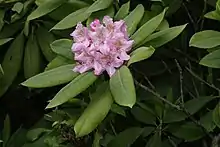Rhododendron macrophyllum
Rhododendron macrophyllum, the Pacific rhododendron,[2] California rosebay,[3] California rhododendron, coast rhododendron or big leaf rhododendron, is a large-leaved species of Rhododendron native to the Pacific Coast of North America. It is the state flower of Washington.[4]
| Pacific rhododendron | |
|---|---|
 | |
| In the Olympic Peninsula, Washington | |
| Scientific classification | |
| Kingdom: | |
| (unranked): | |
| (unranked): | |
| (unranked): | |
| Order: | |
| Family: | |
| Genus: | |
| Subgenus: | |
| Section: | Pontica |
| Species: | R. macrophyllum |
| Binomial name | |
| Rhododendron macrophyllum | |
 | |
| Natural range | |
| Synonyms[1] | |
|
Rhododendron californicum Hook. | |
Description
It is an evergreen shrub growing up to 2–9 m (7–30 ft) tall. The leaves, retained for 2–3 years, are 7–23 cm (3–9 in) long and 3–7 cm (1–3 in) broad. The flowers are 2.8–4 cm (1.1–1.6 in) long, with five lobes on the corolla; color is usually pink, although variants exist.
Distribution
The northern limit of its range is somewhat north of the border between Canada and the United States in British Columbia. It is found as far south as Monterey Bay in California.[5] It is widely distributed in the Coast Mountains and Cascade Range. It is less abundant in the coastal mountains of Washington and northern Oregon and more common south of the Siuslaw River. It is mostly coastal in distribution but extends its range eastward to locations in the Cascade Mountains in Oregon, Washington and British Columbia.[5]
Habitat
Rhododendron macrophyllum, like many rhododendrons, thrives in disturbed habitats such as roadside embankments and recently deforested wildlands. They can also live up in the mountains.
History and cultivation
Archibald Menzies found R. macrophyllum growing along with Arbutus menziesii in May 1792 when he and George Vancouver made their second landfall after leaving Hawaii, near present-day Port Discovery, Washington.[6] Seed was sent to England in 1850 by William Lobb.
In recent years it has been the main focus of a study group at the Rhododendron Species Foundation in Federal Way, Washington, the Western North American Rhododendron Species Project.[7] The WNARSP is documenting the detailed range and forms of all of the western North American rhododendron species.
Toxicity
The species contains andromedotoxin, which can poison the honey of nearby hives.[8]
References
- "Rhododendron macrophyllum". Germplasm Resources Information Network (GRIN). Agricultural Research Service (ARS), United States Department of Agriculture (USDA).
- "Rhododendron macrophyllum". Natural Resources Conservation Service PLANTS Database. USDA. Retrieved 21 October 2015.
- "BSBI List 2007". Botanical Society of Britain and Ireland. Archived from the original (xls) on 2015-01-25. Retrieved 2014-10-17.
- Symbols of Washington State
- Crane, M. F. (1990). "Rhododendron macrophyllum". Fire Effects Information System (FEIS). US Department of Agriculture (USDA), Forest Service (USFS), Rocky Mountain Research Station, Fire Sciences Laboratory – via https://www.feis-crs.org/feis/.
- Justice, Clive L. Mr. Menzies' Garden Legacy, Plant Collecting on the Northwest Coast. 2000. Cavendish Books. ISBN 978-1-55289-020-2
- "Western North American Rhododendron Species Project (WNARSP)".
- Fagan, Damian (2019). Wildflowers of Oregon: A Field Guide to Over 400 Wildflowers, Trees, and Shrubs of the Coast, Cascades, and High Desert. Guilford, CT: FalconGuides. p. 195. ISBN 1-4930-3633-5. OCLC 1073035766.
Other sources
External links
 Media related to Rhododendron macrophyllum (category) at Wikimedia Commons
Media related to Rhododendron macrophyllum (category) at Wikimedia Commons Data related to Rhododendron macrophyllum at Wikispecies
Data related to Rhododendron macrophyllum at Wikispecies